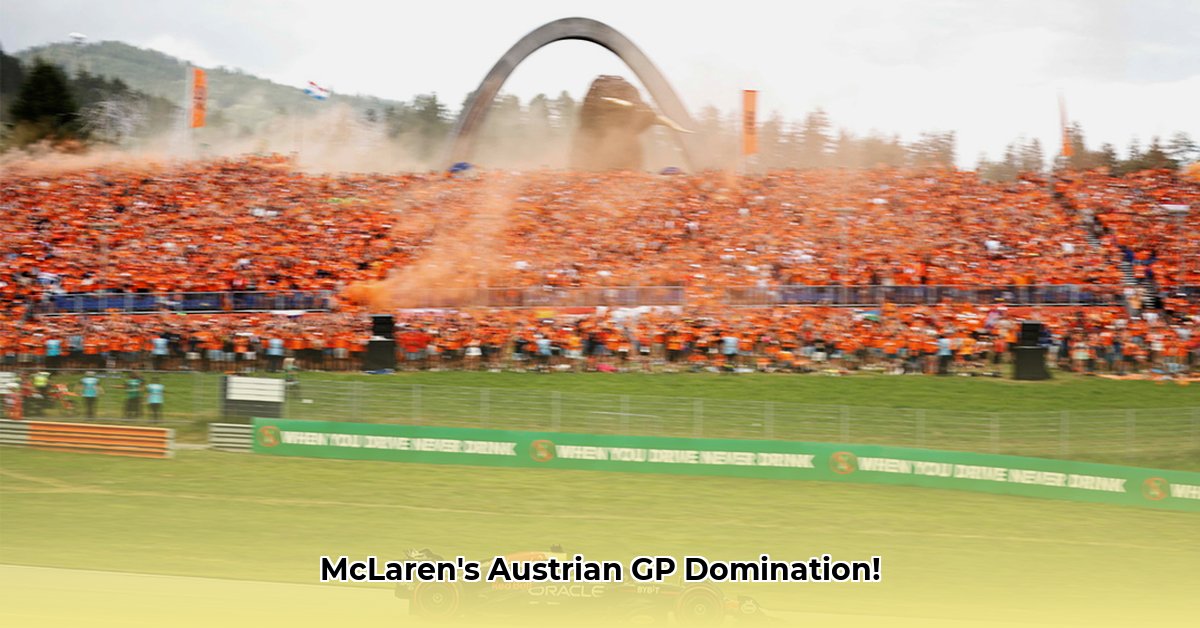
Grand Prix Van Oostenrijk: A McLaren Masterclass
The 2025 Austrian Grand Prix delivered a major upset! McLaren secured a stunning one-two finish, with Lando Norris claiming victory and Oscar Piastri securing second place. This unexpected result was amplified by Max Verstappen's early retirement, a significant blow to Red Bull's championship ambitions. Charles Leclerc managed a podium finish for Ferrari, highlighting their continued competitiveness. Did anyone predict this outcome? This race certainly redefined the championship landscape.
McLaren’s Strategic Brilliance: More Than Just Pace
McLaren's victory wasn't solely attributable to raw speed; their strategic prowess played a pivotal role. Their pit stops were incredibly efficient, showcasing seamless teamwork. More impressively, their tyre management was exceptional – extracting maximum performance while preserving tyre life. This meticulous approach was a key differentiator, highlighting their commitment to strategic racing. How did they manage such precise tyre conservation? This is a question many racing experts will be asking.
Norris vs. Piastri: An Internal Battle
The race wasn't just about beating the competition; an enthralling intra-team battle unfolded between Lando Norris and Oscar Piastri. Norris, leveraging his extensive experience, displayed masterful defensive driving. Piastri, meanwhile, pressed relentlessly, showcasing exceptional talent and pushing Norris to the limit. This internal competition only served to further enhance McLaren's overall performance, but who came out on top? This is a point of significant debate amongst fans.
Verstappen's Retirement: A Turning Point
Verstappen's race ended prematurely following an incident, triggering a safety car period. This unexpected interruption significantly altered the race dynamics, impacting the strategies of all teams. While the precise cause of the retirement is still under investigation, its effect on the race's outcome was undeniable. While speculation is rife, could Red Bull have countered McLaren's strategy without the setback to Verstappen?
Other Key Moments: A Race Full of Drama
The race wasn't without its share of drama. Several close calls between drivers led to yellow flags, adding to the excitement. Although the exact influence of these specific incidents on the final standings remains unclear, they contributed to the overall intensity and unpredictability of the race. The tension kept fans glued to their screens. What impact did these near misses have on the strategic decisions made by the drivers and their teams?
Championship Implications: A Reshaped Landscape
Verstappen's DNF dealt a heavy blow to his championship aspirations. Meanwhile, McLaren's double points haul significantly boosts their championship prospects. While the title fight is far from over, this result fundamentally reshapes the overall contest. The unpredictable nature of Formula 1 has been vividly demonstrated.
Future Outlook: A New Era in F1?
The Austrian Grand Prix served as a stark reminder of McLaren's emergence as a serious championship contender. Red Bull will undoubtedly conduct a thorough post-race analysis of Verstappen's retirement, aiming to prevent similar setbacks. The FIA may conduct an evaluation of safety protocols to prevent similar incidents in the future. The race has redefined perspectives within the sport. The season's remaining races promise intense competition. The battle is far from over and is set to be a nail-biting spectacle.
How McLaren's Tyre Strategy Secured Austrian GP 2025 Victory
The cheers at the Red Bull Ring were deafening. Lando Norris's victory, a McLaren 1-2, marked a resounding triumph at the 2025 Austrian Grand Prix. But their success transcended mere speed; it was a masterclass in strategic tyre management. How did McLaren achieve this incredible feat?
Tyre Degradation: The Defining Factor
The Red Bull Ring, known for its challenging corners and high altitude, puts immense strain on tyres. High degradation rates made tyre strategy absolutely paramount. While many teams opted for a two-stop strategy, McLaren’s approach was refreshingly different and arguably more effective. Their superior tyre management, honed over the season, was showcased to perfection.
Decoding McLaren's Masterplan
McLaren's victory hinges on their ability to maximise tyre performance. Their precise pit-stop timing, coupled with keen understanding of tyre degradation, was instrumental. This was not a reactive strategy but rather a proactive, decisive approach to control the race.
Qualifying Prowess: A strong grid position was essential to successfully execute their strategy, avoiding early-race scraps; crucial for tyre preservation.
Data-Driven Approach: Real-time data (tyre temperature, pressure) allowed dynamic strategy adjustments, responding effectively to track conditions and competitors' moves.
Flawless Pit Stops: McLaren’s pit crew demonstrated exceptional efficiency, minimising time losses; seconds saved could have altered the race outcome.
Driver Expertise: Norris and Piastri's driving styles perfectly complemented the strategy. They managed the car and tyres effectively, ensuring tyre life wasn't compromised during defensive manoeuvres.
Verstappen's Mishap and its Impact
Max Verstappen's early retirement, potentially due to a power unit failure, significantly altered the race's dynamics. This unexpected development created an opportunity McLaren cleverly seized, underlining their preparedness and ability to capitalise on unforeseen circumstances.
The Intra-Team Rivalry: Norris vs. Piastri
The competition between Norris and Piastri provided another gripping element. Both drivers brilliantly executed the same strategy while fiercely battling each other. Although they pushed each other hard, it strengthened McLaren’s overall performance. This internal rivalry added another level of captivating drama to the race.
Pivotal Moments
A late virtual safety car period presented a momentary challenge, but McLaren maintained their position, demonstrating adaptability under pressure. This reinforced their capacity to counter unexpected situations.
Key Takeaways:
- McLaren’s Austrian Grand Prix victory highlights exceptional tyre management and pit-stop execution.
- Verstappen’s early exit significantly impacted the race, creating an opening McLaren expertly exploited.
- The intense intra-team battle between Norris and Piastri added another layer of intrigue.
- McLaren's adaptability and ability to capitalise on opportunities proved decisive.
- A data-driven approach, meticulous planning, and flawless driver execution were crucial to the team’s triumph.